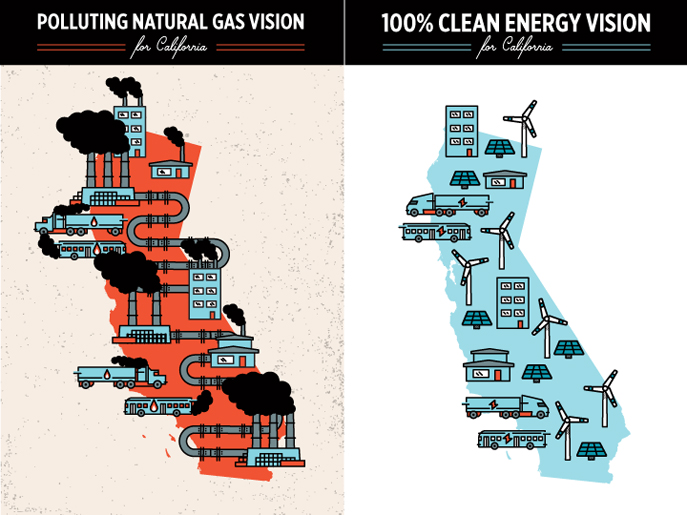Our vision is of a California in which all people can breathe healthy air, all energy is clean and renewable, and everyone benefits from a successful economy and a sustainable environment. In a nutshell, we want to do away with a dirty energy system that ties us to the past, and replace it with one that moves us into the future.
Eventually, California will run on 100% clean, renewable energy. The inevitability of an entirely clean economy in the Golden State has become increasingly apparent. The only question is how fast will we get there.
The gas industry’s vision, though, stands in stark contrast to ours. They envision a California that’s anchored to their dirty product for decades to come. The industry uses undue influence to impede clean energy growth, pushing as many new gas infrastructure projects it can, sinking its teeth into areas like transportation, and making it difficult for buildings and homes to switch from gas appliances to electric appliances.
We can’t continue to let that happen. Natural gas is expensive, dangerous to public health, and a major contributor to climate change. At a time when the climate science is calling for faster action, dirty air days are up (thanks to climate change as well as direct emissions) and when environmental justice communities are under more stress than ever before, we cannot afford to slow down the march of zero-emission technology.
So our work entails tearing down barriers that stand in the way of clean energy’s full potential and delay our march to a brighter future. We organize in local communities across the state to demand decision-makers prioritize pollution-free technology over investments that deepen our reliance on polluting natural gas. Here’s a breakdown of what we’re doing to push back against the dirty gas industry’s plans for California:
-
First and foremost, prioritizing clean energy in communities most burdened by pollution. Low-income, people of color have long been on the frontline of fossil fuel pollution. And inequitable access to clean technology and associated benefits persists to this day. Decision makers must focus zero-emission technology in the most overburdened communities first.
-
No new gas plants. Even with the growth of clean energy like wind and solar, California’s electric sector is still terribly reliant on dirty natural gas. And while we have more energy than we know what to do with, new gas plants keep getting proposed. Over the last decade or more, Californians have been saddled with a wave of new gas plants that neither need nor want. That has to stop. Today cheaper, cleaner, and safer solutions like renewable energy, energy efficiency and even storage are readily available and can meet our needs. Utilities and regulators that continue to favor polluting natural gas over clean energy do so at great cost to our climate, our health, and our energy bills. We’re trying to block new plants and retire the existing ones.
-
Cleaning up homes and buildings: Our homes and buildings produce massive amounts of climate-damaging pollution due to everyday gas-powered appliances like space and water heaters. In fact, gas burned in buildings for heating is responsible for nearly as much carbon pollution as all of the state’s power plants combined.
State and local officials need to show courage and leadership by working together to make the transition from gas to electric barrier-free. Our leaders should support residents who are motivated to do their part in cutting our reliance on fossil fuels. They should, for example, provide rebates and electricity rates similar to what the state offers to electric vehicle drivers.
-
Electrifying the transportation sector. The gas industry is working overtime to establish a foothold in the heavy-duty transportation sector. There’s widespread consensus that there’s an urgent need to move beyond diesel-powered heavy-duty vehicles (big rigs, public buses, school buses, garbage trucks, etc.). But natural gas-powered buses are not the answer. The life of a heavy-duty vehicle spans decades, so we’ll be stuck with still-polluting trucks and buses that dirty our air and damage our climate for long into the the future. Electric buses and trucks on the other hand are price-competitive, cost less to fuel, and have much less fewer maintenance costs, and produce zero emissions.
-
No new pipelines. We need to reduce gas capacity, not add more. A recent investigation by the California Energy Commission and the Public Utilities Commission found that the state’s dirty gas networks leak more methane-- a pollutant 86 more times more damaging than carbon-- every year than the entire Aliso Canyon gas blowout, which is considered one of the worst man-made environmental disasters in history. Yet, Sempra, a natural gas giant, is proposing yet another gas pipeline despite the fuel’s declining demand and lack of need in a thinly-veiled attempt to lock in profits.
Over the course of the next several weeks, we’ll be publishing follow-up blogs to each of these fronts of realizing a clean, equitable future for California.
